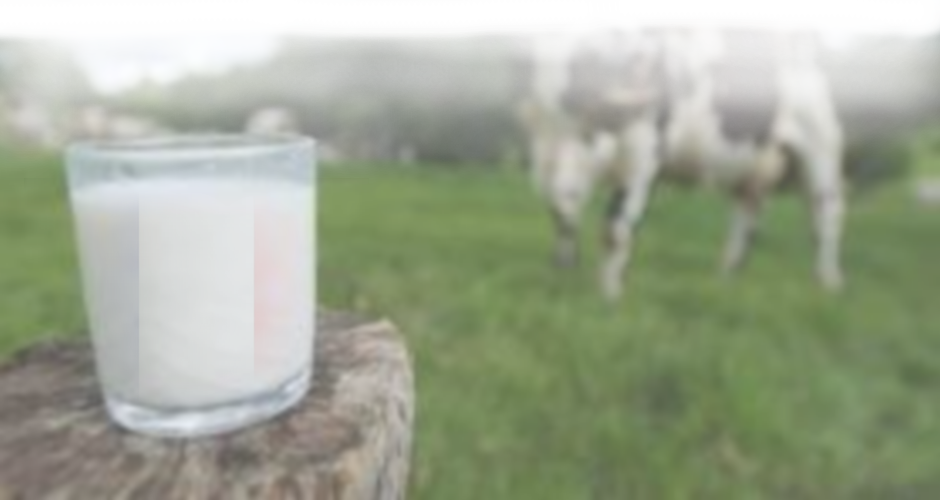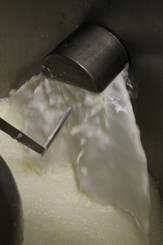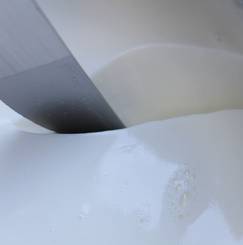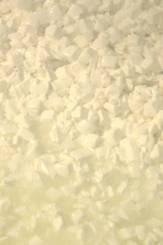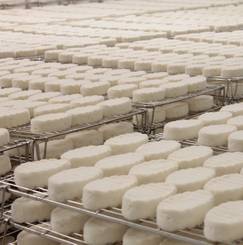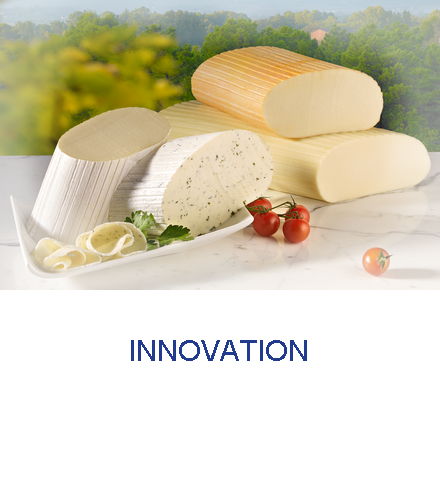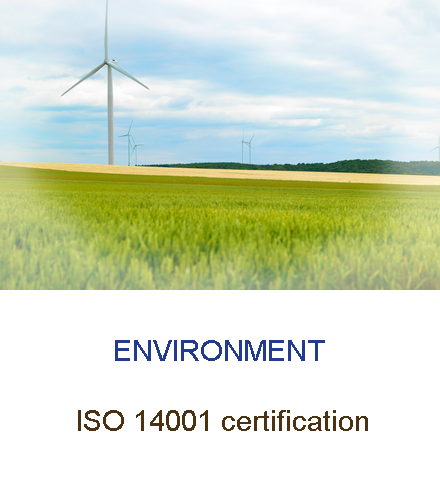Milk
The cheese plant works mainly with cow's milk. But for certain products we also use goat's milk. All our milk is exclusively of French origin.
For our cow's milk we procure it in North East France.
We collect the milk from our own producers and from major cooperatives in the region. As for our goat's milk, we procure it in Rhône-Alpes region.
Land of History
How is cheese made ?
Introduction
Because of the richness of its composition, milk is an essential part of the human diet. Man has always looked for ways of conserving his food. And it's by transforming a liquid (milk) into a solid (cheese) that the cheese maker applies one of the essential principles of conservation: reducing a foodstuff's water content.
By carrying out various operations designed to remove the water while keeping the milk's noble elements the cheese maker creates a bioreactor whose different components will interact to give cheese its delicious characteristics.

Origin and composition of the milk
Milk - the product of the mammary gland of female mammals - is the basic raw material required for making cheese.
The variety of its origins and the complexity of its composition mean that it can be used to create multiple recipes and as many products.
Thus, the species of animal, its breed, feed, rearing and health conditions will all have an enormous impact on the milk's properties, in turn giving the cheeses their own specific characteristics.
The species best suited to giving milk of "cheese-making" quality are cows, goats, ewes and cow buffaloes. Cheeses made from camel, yak and reindeer milk can also be found.
Milk is a dispersed system made of water and what is known as the total dry matter, which includes lactose, fats, nitrogenous substances including proteins, minerals, vitamins and micro-organisms. A delicate raw material, if ever there was one, milk must be treated with great care, under controlled sanitary conditions in order to preserve its qualities as well as possible.
The cold chain is a major factor in this preservation



Step 1: preparing the milk
Before starting the actual manufacturing operation, the milk will undergo some minor changes that will give it given characteristics that are decisive for the rest of the process.
The milk must first of all be selected, in such a way that poor-quality milk is rejected along with the risks of chemical contamination (health products, antibiotics and other substances). Any unwanted physical substances that it may contain will be removed by filtering, centrifugation, decantation (creaming). Without any heat treatment the milk would be sensitive to the development of the micro-organisms it contains.
Depending on the length and holding temperatures, it will undergo what is called a biological maturing, which corresponds to an acidification of the medium. The lactic bacteria then transform the lactose into lactic acid and this acidification will have an impact on the milk's mineral configuration, and protein aggregates.
The milk's behaviour during the cheese-making process will depend strongly on this, which will in turn affect a variety of the future cheese's properties. As they develop, the micro-organisms will also release enzymes which will trigger a "biochemical breakdown" of the milk's components. Cheese transformation companies - which have standards that must be met - often make a selection of specific flora by applying a heat treatment to the milk, and by reintroducing selected cultures, whether live or not.
Milk preparation includes the adjustment of the future cheese's fat content as well as the standardisation of major parameters such as the pH and the quantity and quality of the proteins.

Step 2: curdling
In a traditional cheese-making process, the milk will be made to coagulate before part of its liquid phase is extracted. There are two possible ways of obtaining this coagulation. The first way consists of acidifying the milk. By modifying the proteins' electrical charge the milk will be destabilised and change from a liquid phase (stable) to a solid phase (destabilised). Acidification is obtained thanks to the development of lactic bacteria which, by consuming the lactose, produce lactic acid.
The second means of coagulation also leads to the destabilisation of the milk but this time thanks to the action of an enzyme compound called rennet which will break down part of the casein (one of milk's major proteins) and thus cause the aggregation of protein clusters (micelles). The rennet may be of animal (gastric enzyme) or microbial origin. Both of these processes are used in combination in cheese making. The fact of favouring one or the other will lead to different cheeses. For example, to obtain spreadable fresh cheeses we will favour the acidification method but, on the contrary, for boiled cheeses we will favour the enzymatic method. The curdling of milk then corresponds to a protein network starting to become established, in which the minerals are the cement, and in which the physical-chemistry bonds will gradually solidify the structure. The globules of fatty matter and the micro-organisms will, in particular, be held back in the network's meshes.
Milk curdling in a cheese-making plant is controlled by means of the following: quality and quantity of the proteins and minerals, temperature, coagulant dosage, the milk's pH at the time of renneting.

Step 3: draining into vats
When the cheese maker considers that his network (coagulum) is sufficiently solid for withstanding the mechanical work, and also depending on the type of cheese he wants to make, he will cut the coagulum. The goal is to cut the gel obtained beforehand to create surfaces that will allow the serum to come out (exudation).
By acting on the size of the grains, you act on the exchange surface area. The smaller the grains, the greater the serum's ability to escape from the curd grains. Ladle moulding is a rough cutting of coagulum which favours serum extraction to a lesser extent.
The speed at which the serum is expelled is one of the major parameters in a cheese recipe.
Because, although the transformation of the lactose into lactic acid by the lactic bacteria is carried out inside the curd grain, it will have a demineralising effect whose consequences on the finished product will be real. On the contrary, when the serum leaves the grain, it carries part of the lactose away with it thus preserving the cheese from excessive demineralisation. Depending on the type of cheese being made, the combined kinetics of the acidification and of the expulsion of the serum are decisive.
The serum will be completed in the vat by mechanical actions: stirring. The purpose is to prevent too fast an agglomeration of the curd grains as that would hinder the outflow of serum. It is a question of putting or maintaining the curds in suspension. The draining into vats can be improved by increasing the temperature (eg: hard pressed cheeses). The temperature, favourable for the construction of chemical bonds, increases the gel's powers of contraction, which will cause more serum to be expelled.
Other processes are applied to promote the extraction of the serum, such as centrifugation of the curds (spreadable fresh cheeses).

Step 4: draining into moulds
The way you mould the curds will also be decisive for the cheese's future characteristics. Besides the shape that it is designed to impose, the mould will also contribute to perfecting draining. In cheese baskets, the draining is static and spontaneous. For soft ripened cheeses, the products are moulded in more or less porous materials and are turned over several times. For pressed cheeses, the cake of curds and then the cheese in its mould, undergo a mechanical pressing action, the goal of which is to ensure more serum is expelled
Be that as it may, draining will always depend on the acidification kinetics caused by the starters.
Indeed, when the lactic acid accumulates inside the grains, it makes the curds more permeable. And this promotes the extraction of the water.
Draining, which depends on the time/temperature pair, continues as required through to complete acidification of the product. The cheese can then be salted, by brining or surface salting. This will further complete the draining as the salt helps to expel the water.



Step 5: from ripening to conservation
Other micro-organisms will now complete the work of the lactic bacteria. This concerns the cheese refining agents. Depending on their nature and the conditions under which they well be allowed to develop, they will give the future product its character, its typical features. It is owing to their ability to transform the cheese molecules thanks to the action of the enzymes that they secrete that these organisms will give the aromatic compounds that are responsible for the cheese's taste.
The temperature, the ambient humidity and the renewal of the air in the plant are all parameters that help to control the ripening conditions
We also use the term 'cellar care' when we turn the cheeses over or rub them. The goal being to make the surface of the products uniform so that the chosen microbes can develop correctly. The overturning operation also helps to distribute the humidity. The products' packaging is specific to each type of cheese. But in every case it interacts with the cheese to complete or delay its ripening.
Anyway, the cheese, a living substance, will always evolve through until its consumption limit date. The seat of complex biochemical reactions, its evolution will be controlled to obtain the best trade off between taste and nourishment.
Anyway, the cheese, a living substance, will always evolve through until its consumption limit date. The seat of complex biochemical reactions, its evolution will be controlled to obtain the best trade off between taste and nourishment.

General Manager :
Phone :
Address :
Capital :
Legal structure :
SIREN (Company ID No.) :
APE (Company activity code) :
VAT No. :
Hosted by :
Webmaster :
Josef STITZL
03.29.87.23.23
Fromagerie Henri Hutinrue du Rattentout55320 Dieue-sur-meuse
1.500.000 €
485.920.227 R.C.S. Bar-le-Duc
485.920.227.00033
1051C
FR73485920227
1 hébergement400 avenue RoumanilleBP 6017706903 Sophia AntipolisCedex - FR
IT dept. - Fromagerie Henri Hutin
Terms & Conditions - Fromagerie Henri Hutin
HistoryThe GroupOur CustomersOur Values
R&D InnovationQualityProduction ToolThe Environment
Our soft ripened cheeses - Large formatsOur soft ripened cheeses - Small formatsOur pressed soft ripened cheesesOur spreadable fresh cheeses
Our ProfessionsPositions vacantWork experience and work/study programmesGreat Place To Work
French MilkLand of HistoryHow is cheese made?
Site map - Fromagerie Henri Hutin


